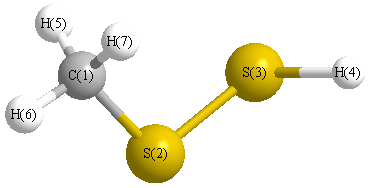Vibrational Frequencies calculated at TPSSh/aug-cc-pVTZ
| Mode Number |
Symmetry |
Frequency
(cm-1) |
Scaled Frequency
(cm-1) |
IR Intensities
(km mol-1) |
Raman Act
(Å4/u) |
Dep P |
Dep U |
|---|
| 1 |
A |
3138 |
3029 |
6.22 |
58.65 |
0.75 |
0.86 |
| 2 |
A |
3121 |
3012 |
6.25 |
83.73 |
0.75 |
0.86 |
| 3 |
A |
3035 |
2930 |
17.71 |
206.08 |
0.03 |
0.06 |
| 4 |
A |
2622 |
2530 |
6.21 |
170.90 |
0.22 |
0.36 |
| 5 |
A |
1487 |
1435 |
7.88 |
4.39 |
0.71 |
0.83 |
| 6 |
A |
1466 |
1415 |
7.82 |
5.55 |
0.75 |
0.86 |
| 7 |
A |
1342 |
1295 |
3.99 |
0.56 |
0.29 |
0.45 |
| 8 |
A |
971 |
937 |
4.65 |
1.40 |
0.09 |
0.16 |
| 9 |
A |
967 |
933 |
2.44 |
0.50 |
0.16 |
0.27 |
| 10 |
A |
874 |
844 |
4.83 |
11.53 |
0.40 |
0.58 |
| 11 |
A |
684 |
660 |
1.50 |
14.04 |
0.23 |
0.37 |
| 12 |
A |
506 |
488 |
0.70 |
11.45 |
0.12 |
0.22 |
| 13 |
A |
339 |
327 |
12.12 |
0.93 |
0.75 |
0.85 |
| 14 |
A |
231 |
223 |
0.21 |
5.54 |
0.50 |
0.67 |
| 15 |
A |
161 |
155 |
0.35 |
0.01 |
0.75 |
0.86 |
Unscaled Zero Point Vibrational Energy (zpe) 10471.4 cm
-1
Scaled (by 0.9652) Zero Point Vibrational Energy (zpe) 10107.0 cm
-1
See section
III.C.1 List or set vibrational scaling factors
to change the scale factors used here.
See section
III.C.2
Calculate a vibrational scaling factor for a given set of molecules
to determine the least squares best scaling factor.
Charges, Dipole, Quadrupole and Polarizability
Charges from optimized geometry at TPSSh/aug-cc-pVTZ
Charges (e)
| Number |
Element |
Mulliken |
CHELPG |
AIM |
ESP |
| 1 |
C |
-0.297 |
|
|
|
| 2 |
S |
-0.106 |
|
|
|
| 3 |
S |
-0.176 |
|
|
|
| 4 |
H |
0.106 |
|
|
|
| 5 |
H |
0.184 |
|
|
|
| 6 |
H |
0.129 |
|
|
|
| 7 |
H |
0.159 |
|
|
|
Electric dipole moments
Electric dipole components in Debye
(What's a Debye? See section
VII.A.3)
| |
x |
y |
z |
Total |
| |
-1.084 |
1.188 |
0.755 |
1.777 |
| CHELPG |
|
|
|
|
| AIM |
|
|
|
|
| ESP |
|
|
|
|
Electric Quadrupole moment
Quadrupole components in D Å
Polarizabilities
Components of the polarizability tensor.
Units are
Å
3 (Angstrom cubed)
Change units.
| |
x |
y |
z |
| x |
10.979 |
0.159 |
0.171 |
| y |
0.159 |
8.002 |
0.056 |
| z |
0.171 |
0.056 |
6.998 |
<r2> (average value of r
2) Å
2
| <r2> |
102.810 |
| (<r2>)1/2 |
10.140 |
